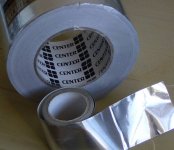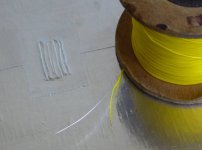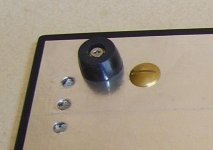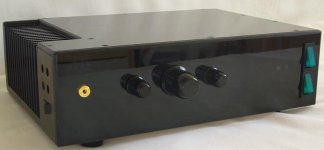I recently purchased a bunch of boards from chipamp.com and am now planning on building the chassis for them. I plan on making three amplifiers, two channels each. All will be mono-block construction. My question is, I am thinking of making one of the chassis - the entire chassis - from clear acrylic. The feet, front panel, rear panel, volume knob, fasteners (if used instead of cement) everything . . .
So, am I going to have EMI / RF issues by not using a metal enclosure?
Would a star ground be all I need?
I guess I should ask, is there something else that I would have to do differently?
Thanks.
So, am I going to have EMI / RF issues by not using a metal enclosure?
Would a star ground be all I need?
I guess I should ask, is there something else that I would have to do differently?
Thanks.
not exactly your size requirements but I have made one in the past without much problems. Hopefully, you might get an idea or two from it. 🙂
Mini Test Oscillator
Mini Test Oscillator
Mock it up in cardboard first just to make sure. If you use a star ground and shielded signal cables you should be OK.
Higher quality window tint uses metallic particals rather then dye, it's know to cause poor radio and GPS reception in some cars.
Glass and tint could be a plan "B".
Glass and tint could be a plan "B".
I am planning to use Acrylic too. I might suggest you use a metal base - I have mounted the TFR and AMPs with Heatsink on the metal base.
I build all my amplifiers up in an experimental form without any case/chassis............... am I going to have EMI / RF issues by not using a metal enclosure?
Would a star ground be all I need?
I have never found any power amplifier to be quieter after installing it inside a metal chassis.
Are there any exposed conductive parts?
That answer will determine whether you need to connect those parts to Safety Earth and determine what you do with the PE (third wire in the mains cable).
Depending of your electronic environment...
I made a wood + altuglass (plexiglass ?) chassis for a LM3875 AudioSector kit and unfortunately I got a strong noise from a DETC phone and also a nice FM radio although not the right one 🙁
First, I shielded all signal cables but nothing improved !
FM radio was just fixed by adding an RC filter at input and 300pF at chip legs.
For the telephone noise, I had to shield the entire box, including base and top, with a self-adhesive aluminum tape. It is hard to do after the amp is done and all the bands must be connected to the main ground, but happily it handled ~98% of the problem.
Now, next amp will have a wood chassis too as it is so easy to work and modify. But sure I will use the aluminum tape before installing electronics parts 🙂 !!!
Aluminum tape is used for connection of the panels of insulation under roof
Edit : oups, sorry MadHattter, I realise the aluminum is not really 100% transparent...
I made a wood + altuglass (plexiglass ?) chassis for a LM3875 AudioSector kit and unfortunately I got a strong noise from a DETC phone and also a nice FM radio although not the right one 🙁
First, I shielded all signal cables but nothing improved !
FM radio was just fixed by adding an RC filter at input and 300pF at chip legs.
For the telephone noise, I had to shield the entire box, including base and top, with a self-adhesive aluminum tape. It is hard to do after the amp is done and all the bands must be connected to the main ground, but happily it handled ~98% of the problem.
Now, next amp will have a wood chassis too as it is so easy to work and modify. But sure I will use the aluminum tape before installing electronics parts 🙂 !!!
Aluminum tape is used for connection of the panels of insulation under roof
Edit : oups, sorry MadHattter, I realise the aluminum is not really 100% transparent...
Attachments
Last edited:
Refer to this site, and if possible his book 'Electromagnetic Compatability Engineering' it is the definitive tome on solving these sort of problems (pages 116-140, covers various grounding schemes).
http://www.hottconsultants.com/
If you want to put PCB's in unshielded plastic boxes then for RF immunity the EMC protection has to start at board level and realy requires ground planes.
Oh and Keith Armstrong, Tony Waldren articles from this site:
http://www.compliance-club.com/
http://www.hottconsultants.com/
If you want to put PCB's in unshielded plastic boxes then for RF immunity the EMC protection has to start at board level and realy requires ground planes.
Oh and Keith Armstrong, Tony Waldren articles from this site:
http://www.compliance-club.com/
@AndrewT : by including silver plated cables, under an aluminum "patch". And also, at bottom, plated by the brass screw with broad head of the main ground... the same into the amp.
Attachments
Last edited:
We made an enclosure for a device at work out of clear acrylic. It was all slotted together with ... T-shaped slots, I guess, and mating T-shaped protrusions on the parts at right-angles. You pushed the 'T' into the slot and then slid it sideways to lock it into place. Once other parts of the assembly were fitted they obstructed disassembly. It was successful, but problematic too, because the material is quite weak, so we had a lot of breakages in assembly. We also used clips made in the form of a half-arrowhead. The bottom end was glued into a matching laser cut hole in a sheet. When the mating piece was pushed into place the wedge of the arrow was pushed aside because the shaft flexed, then it snapped back onto a flat to trap the mating piece. This was another good idea that ran into problems because the material didn't flex as expected. We had to introduce cutout circles at the internal rightangles to spread the stress lines.
Interesting, but with some comebacks to bite you in the a**. I'd have a plan B.
Interesting, but with some comebacks to bite you in the a**. I'd have a plan B.
As a plastic, acrylic (perspex) is unusually brittle.
As post11 says it is also very susceptible to notch stress.
As post11 says it is also very susceptible to notch stress.
yes it is brittle... on my amp, only the top is full Plexiglas as there is no stress there.
But at front, the mechanical parts (2 switches and 1 pot) are fixed on the wood, the Plexi is just there for eye-candy and glued with double face tapes on the wood part.
Of course it can't be let transparent, so the verso is painted in black.
I like it but it is delicate, nobody but me may touch it 🙂
But at front, the mechanical parts (2 switches and 1 pot) are fixed on the wood, the Plexi is just there for eye-candy and glued with double face tapes on the wood part.
Of course it can't be let transparent, so the verso is painted in black.
I like it but it is delicate, nobody but me may touch it 🙂
Attachments
Last edited:
Thanks for all of the info everyone. I am thinking of getting a plain box with the dimensions of approximately 15" x 10" x 3" or so from here: ClearPC | Clear Acrylic Cases, Secure Housings, Enclosure Fabrication, Clear Covers, Game System Cases, XBOX, WII, Playstation, Security Cases, Acrylic Boxes, Acrylic Containers
I like building these chip amps because:
1) They are easy to build when you have a great community here with group buys for pc boards, companies like chipamp.com and audiosector.com and others (those are the two I have personally dealt with).
2) They are relatively easy to troubleshoot due to the extensive knowledge here on the forums.
3a) *segue ahead* When I was growing up, my dad did electrical design, prototyping, and small batch assembly of circuit boards. I remember watching him work and explain things to me - what they did, how they worked, etc. . .
3b) I want to pass that to my son - 6 years old - by having this so he can see every part of the system and see it is not a "magic box" that just makes things louder. It works because of each component doing it's job.
4) I mean, how cool would it to be to have a crystal clear amplifier chassis!?
IF the amp has a bit of noise, depending on how bad it is, I may ignore it. If it is too bad, I may just keep it as a show and tell piece. Show it off and say "That's what is in that aluminum enclosure over there that you can't see in."
I like building these chip amps because:
1) They are easy to build when you have a great community here with group buys for pc boards, companies like chipamp.com and audiosector.com and others (those are the two I have personally dealt with).
2) They are relatively easy to troubleshoot due to the extensive knowledge here on the forums.
3a) *segue ahead* When I was growing up, my dad did electrical design, prototyping, and small batch assembly of circuit boards. I remember watching him work and explain things to me - what they did, how they worked, etc. . .
3b) I want to pass that to my son - 6 years old - by having this so he can see every part of the system and see it is not a "magic box" that just makes things louder. It works because of each component doing it's job.
4) I mean, how cool would it to be to have a crystal clear amplifier chassis!?
IF the amp has a bit of noise, depending on how bad it is, I may ignore it. If it is too bad, I may just keep it as a show and tell piece. Show it off and say "That's what is in that aluminum enclosure over there that you can't see in."
Last edited:
Just had a new thought - what about the semi-transparent plastic used for ESD bags? Coat the inside of the plastic chassis with this and use bright LEDs to illuminate the components.
I build amps on a module with heavy "L" aluminum. This bolts right upon the heatsink. This helps with shielding. Very short board paths, star ground, twisted or shielded signal lines and HF shunting cap on the input keep the amp dead silent without a proper case.
I stuffed this into a Radioshack project case. I used this method because having the board stick out 90 Deg from the heatsink didn't give me the room. This way the board and heatsink are better mechanically (no flexing relative to the heatsink that could stress solder joints. This amp was meant to go portable.
An externally hosted image should be here but it was not working when we last tested it.
I stuffed this into a Radioshack project case. I used this method because having the board stick out 90 Deg from the heatsink didn't give me the room. This way the board and heatsink are better mechanically (no flexing relative to the heatsink that could stress solder joints. This amp was meant to go portable.
Last edited:
It certainly provides no RF or other shielding, and it's probably not up to snuff for fire protection. Technically it's a horrible choice, but I understand the desire to do it. I've made Plexiglas tops for some of my amps in the past to show off the construction. If you can find it surplus as cutoffs, I'd consider Lexan (polycarbonate) as a much more rugged alternative. It's nearly impossible to break, but it's also quite expensive.
- Status
- Not open for further replies.
- Home
- Amplifiers
- Chip Amps
- Thinking of Making A Chassis from Clear Acrylic. Thoughts?



